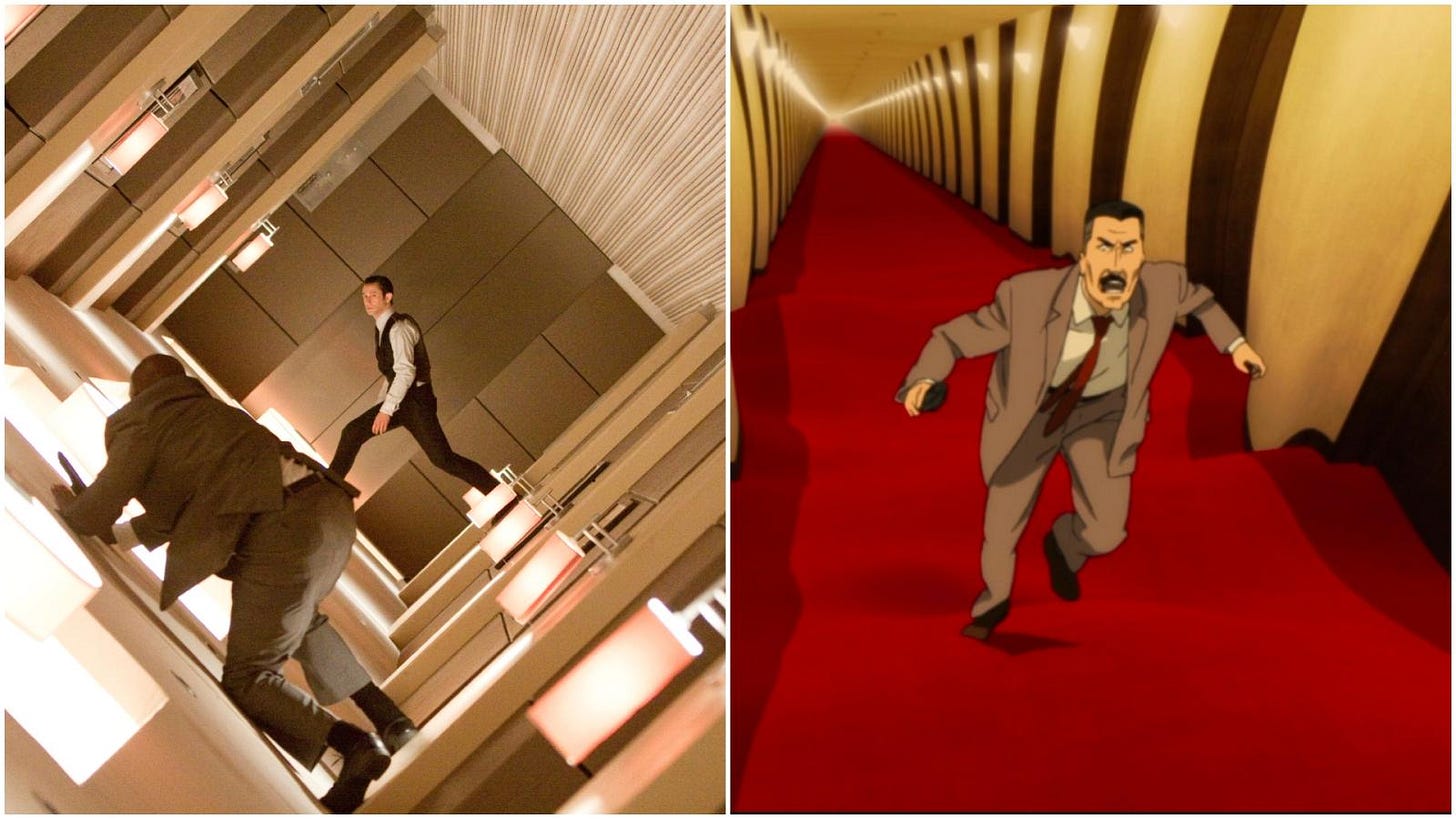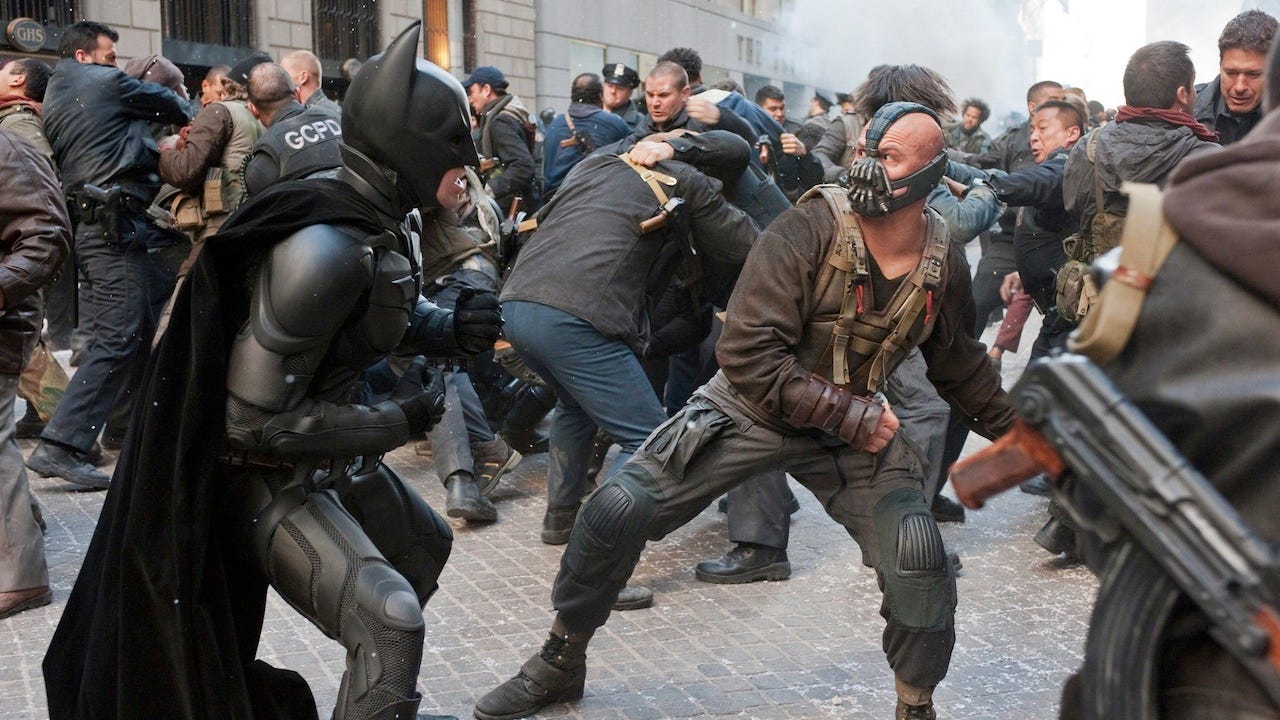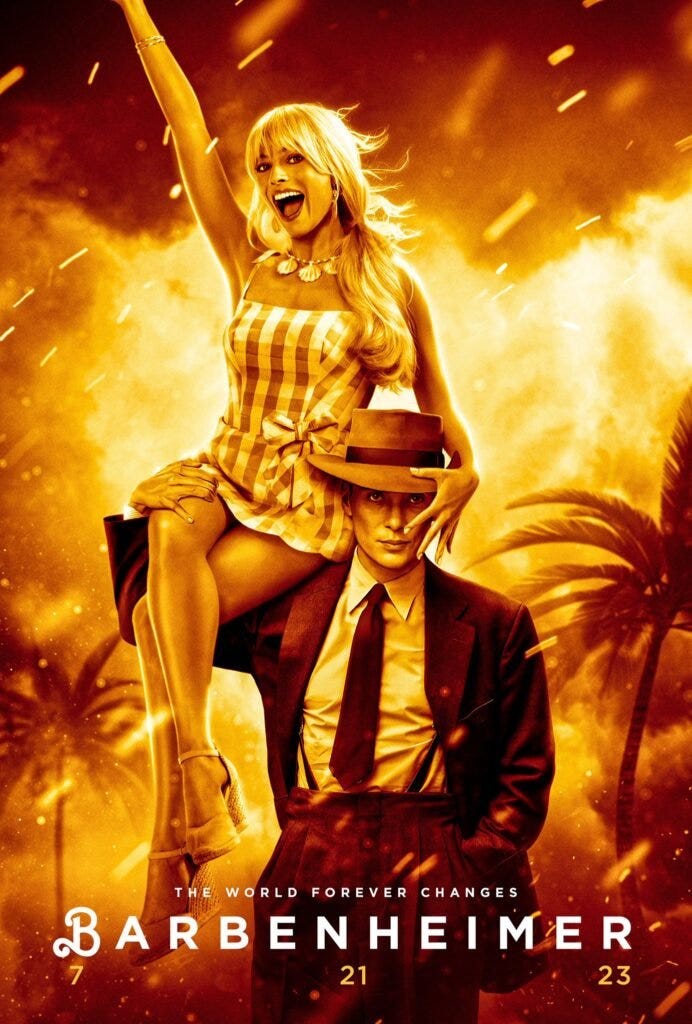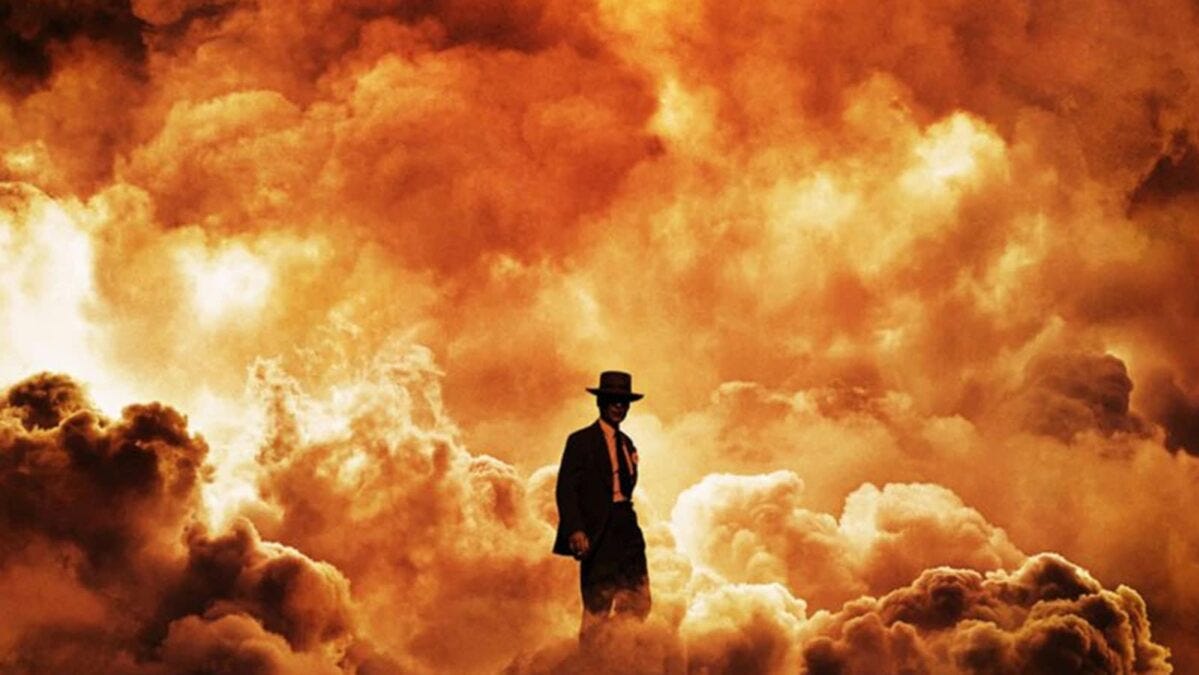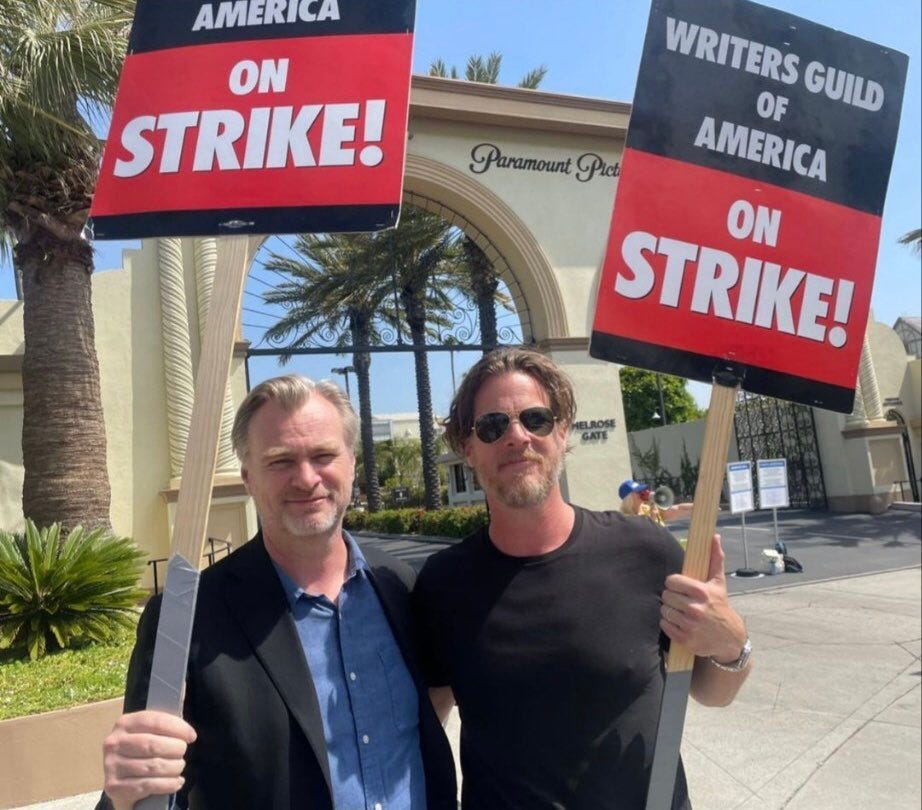Good morning! Here, as I somewhere between promised and threatened, is my essay about Barbenheimer. Much like the portmanteau itself, today’s letter is more Oppenheimer than Barbie. By which I mean it is quite long and dense. So, if you’d like to read the whole thing, click the link above to read this in your browser. If you have a Spotify account, I’d also encourage you to put the playlist below on shuffle while you read. No pressure though. Spoilers abound for Barbie, Oppenheimer, Paranoia Agent, Paprika, Inception, and 20th century classical music.
-04: DSCH (Recreation of a Personality)
In 1959, American composer and conductor Leonard Bernstein undertook a ten-week tour of the Soviet Union with the New York Philharmonic Orchestra, performing music by both American and Soviet composers as a gesture of friendship and cultural exchange between the two rival world powers. During a performance in Moscow that was televised to an American audience back home, Bernstein took a moment to praise one Soviet composer in particular. Before performing the first movement of his 7th symphony, Bernstein personally thanked Dmitri Shostakovich from the stage “for the wonderful music he has given us.” Egged on by the applause of the audience, Shostakovich, shy, bespectacled, and visibly anxious, hurried down to the stage to shake Bernstein’s hand and bow to the audience before vanishing back to his seat.
Shostakovich had every right to be anxious. That he was even present to give this literal handshake across the ideological aisle in 1959 was by no means a given. The composer, born in 1906, enjoyed a varied and complicated relationship with power, having by this point vacillated from national hero to dead-man-walking twice over. Ten years before Moscow showered him with applause his work was banned from Soviet stages for being too influenced by Western aesthetics. 17 years before Bernstein gave his interpretation of the 7th, an orchestra of 14 musicians performed the symphony in Leningrad, where Shostakovich had composed most of the work during a Nazi siege that still raged by the time of its debut. Shostakovich’s life and music were riddled by these kinds of historical contradictions.
Shostakovich rose to prominence in the 1920s, earning a living composing music for films while developing his voice. Though quiet and reserved in person, Shostakovich’s music overflowed with personality. In his work for the screen he displayed a knack for musical irony, twisting popular melodies to comment on the action to the audience. His concert work was just brazen. Shostakovich specialized in the grotesque, pushing his compositions until their beauty boiled over into unsettling dissonance. This challenging and modern style culminated in the opera Lady MacBeth of Mtsensk, a work that made Shostakovich a star in the international world of classical music and a target of Stalinist repression at home.
Following the opera’s premiere an editorial in the state paper Pravda titled “Muddle Instead of Music” dismissed the piece as a work of bourgeois formalism, “unbearable to hear and impossible to remember”. Though unsigned, the scathing review could not have been published without Stalin’s implicit approval. Aware that his every move was under potentially lethal scrutiny, Shostakovich declined to premiere his 4th Symphony. This may have saved his life. The 4th symphony was a panic attack in three movements, full of claustrophobic volume and eerie silence. Every moment of catharsis is undercut by hideous discordance. Shostakovich had written a masterpiece of the exact kind of modernism The Party frowned on.
Instead in 1937 Shostakovich premiered his 5th Symphony, which he claimed embraced socialist realism and represented the “recreation of a personality”. The party accepted this mea culpa and the composer returned temporarily to Stalin’s good graces. To be certain, the 5th is a far more accessible symphony than its abandoned predecessor. Shostakovich never hides the familiar tropes underlying each movement. You want a canon? Here’s a canon. Even after a prolonged storm of D minor in the finale he brute forces a happy ending in D major, a symbol both of his willingness to play to the audience and of the relief of getting the heat off his back. Don’t get me wrong, Shostakovich sounds like he was composing like his life depended on it both literally and figuratively. However, after the 4th symphony was finally premiered in 1961, audiences may have heard the music in a different light. Scattered throughout this so-called recreation of Shostakovich’s personality were unmistakable echoes of the 4th’s mortal paranoia. The eerie celeste theme that closes out the first movement for example, is almost directly lifted from the end of the 4th symphony’s finale. Each reused melody and motif from the 4th punctures the 5th’s party-friendly surface, allowing the audience a glimpse into Shostakovich’s true state of terror.
For the rest of his career, whether he was a stiff middle manager in the Communist party or a blacklisted bourgeois formalist, Shostakovich relied on this sleight of hand to express himself. He had in a sense become the film composer to his own life, playing the good Soviet on the surface but leaving just enough ironic distance for the audience to question what they heard. He wrote melodies too sweet and marches too squeaky to be taken seriously, but delivered them with enough force to avoid suspicion from the party. Once you notice the intentional seams in Shostakovich’s work they are hard to ignore. Everything begins to feel overexposed, audibly creaking under the weight of its own agreement. In Shostakovich’s wide arsenal of ironic barbs, his most ingenious was a musical watermark; a sequence of notes that translated in Russian notation to the initials DSCH. With this short phrase Shostakovich could remind the audience at any time that he was there, brazen as ever beneath the facade of compliance. These notes said what Shostakovich could not; that he would always be the master of his own creativity, that he was still human.
-03: Paranoia Agent no Fuan
Paranoia Agent, which first aired in Japan in 2004, is a story with two mascots and no main character. Helmed by film director Satoshi Kon, the thirteen episode animated television show follows a rotating cast of characters in Musashino, Tokyo, each losing their mind in unique and individualized ways. Loosely tying this ensemble together are two seemingly unrelated mass hysterias: terror over a string of violent assaults committed by a roller-blading teen nicknamed Shonen Bat, and feverish enthusiasm for an adorable, pink cartoon dog named Maromi. Tsukiko Sagi, the first of Paranoia Agent’s temporary protagonists, stands in the eye of both storms simultaneously.
When the first episode of Paranoia Agent begins in earnest, Tsukiko Sagi is a graphic designer at a company reminiscent of Sanrio (the Hello Kitty people). Sagi’s latest work, Maromi, is a huge hit, but her bosses are already breathing down her neck for a follow up. With a Maromi plushie staring down at her from the top of her PC and resentful coworkers giving her the stink-eye across the hall, Sagi tries and fails to draw another mascot. Instead she dreams up something much worse. The next morning Sagi is in the hospital from an attack by a mysterious assailant, who she describes to the police as a teenage boy with golden rollerblades and a golden baseball bat. The two detectives, gruff, practical, middle aged Detective Ikari and fresh-faced, intuitive, young Detective Maniwa, take a typically divided Scully & Mulder stance about the legitimacy of the attack. The public and the media however take the report and run with it, dubbing the perpetrator Shonen Bat. By the end of the episode there’s another victim, with plenty more to come.
Paranoia Agent may not have a single main character, but it orbits closest to Ikari and Sagi. Ikari is a textbook diagram of aging masculinity, with forearms as wide as his head and a liver that can absorb a pint of beer in one go. He is, of course, unable to express any emotions other than frustration, mostly at a world that has left him behind, or stoic resilience in the face of the same. He gets nostalgic over old brands of matches that remind him of the post-war Japan of his childhood and shakes his head at the nihilism of the modern criminal (across seas literal and metaphorical, Tommy Lee Jones nods silently in sympathy). Sagi has just as much trouble expressing herself but for different reasons. Painfully shy, occasionally bespectacled, Tsukiko Sagi has a habit of trailing off in the middle of conversations. It can be hard to tell when her aloofness comes naturally and when it’s an act of evasion. Sagi never once stands up for herself, makes eye contact under only the gravest of circumstances, and is incapable of speaking above a whisper. These two couldn’t be further apart on the surface, which is of course Satoshi Kon’s point. Both characters are running from something, albeit in different directions, but what?
As a director, Satoshi Kon was fascinated by the thin line between the world of ideas, of movies, dreams and symbols, and mundane job-having, bill-paying physical reality. Frequently his characters slid from one side of that metaphysical divide to the other. Maromi and Shonen Bat are no exceptions, acting as both “real” characters with spoken lines, and as vague social concepts. Memes, in the traditional sense. Maromi and Shonen Bat go viral in tandem. Each episode of Paranoia Agent follows a new character buckling under the weight of their own psychic burdens, punctuated by an attack from Shonen Bat just as the tension is at its highest. With each new victim, new rumors spread about Shonen Bat, transforming him in turn from a teenage boy to an urban cryptid complete with fangs and demonic powers.
The more monstrous Shonen Bat becomes, the deeper Tokyo descends into Maromi-mania. Maromi’s round face and gentle urge to “take a break” proliferates in the background of Paranoia Agent, adorning keychains, t-shirts, balloons, and every manner of collectable toy. Maromi even gets a show-within-a-show, produced under such stressful conditions that most of the staff succumb to Shonen Bat before the first episode airs. Although it isn’t until late in Paranoia Agent that anyone says it outright, Satoshi Kon isn’t subtle in connecting the dots between Maromi and Shonen Bat. During the show’s opening theme the cast laughs uproariously as disaster (mushroom clouds, for example) looms in the distance, ending on Shonen Bat’s mischievous grin. The show’s ending theme concludes with the cast asleep at a giant Maromi’s feet. The two mascots are an inverted reflection of each other. Both offer temporary release from the unresolved contradictions of modern life. One is a violent rupture of the social fabric, the other is a numbing balm for the same wounds. But neither can stave off the pressure forever.
Eventually the tension between these two memetic forces becomes too great to endure. At the climax of Paranoia Agent’s final episode, a Maromi as tall as a building battles against a sea of black ooze. The two eventually become a tangled mass of black and pink that roars through the city streets. The destruction only ceases when Tsukiko Sagi admits, not to the world but to herself, her own complicity in creating both icons. Detective Ikari, having overcome his nostalgia for the past, stumbles out into the wreckage and describes what he sees as “like right after the war.”
-02: Competing Dream Machines
Two years after the conclusion of Paranoia Agent, Satoshi Kon gave the idea of a city-scale brawl between two contrasting concepts another go. Paprika, Kon’s final completed film before he died of cancer in 2010, concludes with a kaiju-sized battle between a creator and their patron. In one corner, dressed in bright red, is Paprika, the dream alter-ego of Dr. Chiba, a psychiatrist who treats patients from the inside of their dreams. In the other, rendered in permanent greyscale, is Dr. Inui, Chiba’s boss, who has, through a series of mishaps, fused with the concept of death itself and seeks to drag all of humanity into the void with him.
How two psychiatrists have come to tower skyscraper-high for a showdown in downtown Tokyo is nearly impossible to explain in words. Paprika operates on the wildest edges of movie and dream logic. Kon made full use of the animated medium to shatter all notions of realism, instead throwing his characters and audience into a kaleidoscopic swirl of shapes and colors, taking leaps in narrative and visual grammar that would be irrepeatable in live action film. The results are perhaps the greatest achievement in stoner cinema, clocking in at an airtight 90 minutes.
Underneath its fantastical surface however, Paprika tells a fairly straightforward story about the conflict between the good intentions of inventors and the craven aims that guide their creation’s use. At the center of the story is the DC Mini, a device invented by the naive, childish Dr. Tokita, that allows its user to enter and effect another person’s dreams. Tokita, along with Chiba/Paprika, develop the DC Mini as a therapeutic tool. Their boss, Inui, has different ideas. Inui (under the influence of too much German idealist philosophy, probably) wants to prevent humans from despoiling the realm of pure Thought and uses the DC Mini to drive his staff to insanity and suicide. The struggle over the use of the DC Mini eventually collapses the distinction between the waking world and dreams, unleashing chaos on an unimaginable scale. Take away all the sci-fi absurdity and the fundamentals are universal: no matter how well intentioned, new and powerful technology can cause irreparable harm in the wrong hands.
Kon, a post-modernist till the end, litters Paprika with allusions to other films, his own and classics like North by Northwest, Tarzan, and the work of Akira Kurosawa. The implication being that movies are their own kind of dream machine, capable of rendering our subconscious desires as larger-than-life spectacles. Kon was not the first and would not be the last director to make this connection. Only four years after Paprika, British director Christopher Nolan offered a far more cynical take on the art of dream-weaving. In Inception Nolan renders film-making as a heist, engineered by professional mercenaries to exploit psychological soft spots (daddy issues, dead wives etc) for financial gain.
Ever since it debuted in the summer of 2010, fans of Paprika have scrutinized Inception for its similarities to Kon’s swan song. The comparison does Inception few favors. Nolan has none of Kon’s surrealist slapstick, kinky eroticism, or counter-culture flair. In place of Paprika’s spring-time psychedelic sprawl, Nolan renders the world of dreams in gun-metal grey and ice-cold blue. One could easily ding Nolan for lacking imagination and urge him in the words of his own script to “dream a little bigger”, but doing so ignores two key facts about the film. First, Christopher Nolan is literally red-green colorblind so um, do better??1 Second, the dream technology in Inception wasn’t invented by the medical sector as it was in Paprika, but by the military. Every crucial difference in Nolan’s depiction of the dreamworld, the drab professional interiors, the staging of dreams as theaters of war complete with armed enemy combatants, and the shadowy figures interloping in the subconscious, flows from this martial origin.
Inception isn’t a failed recreation of Paprika but an illustrative compliment to it. Viewing the two alongside each other only proves Kon’s point. We can either use our imagination to heal others, or to coerce and manipulate them. It all depends on who controls the technology and who creates the dreams.
-01: Ripples
Paprika was a modest success for an artsy animated film released before anime truly went global. Inception on the other hand was a smash. Maybe I was just 19 when it hit theaters, but Inception was the topic of heated debate (“is it all a dream?” vs “is it actually any good”) in every social circle and corner of the internet that I occupied in 2010. Successes of this magnitude breed imitators in the movie business. Inception was no exception. However, with more than a decade’s hindsight the film’s impact didn’t come in the form of stylistic copycats. No notable sci-fi dream heists followed in its wake. Instead, Inception’s effect on American cinema rippled out from how the film was marketed and from the concessions Nolan gave in order to direct it in the first place.
Inception was announced not with a slogan, but with a BWAM. 22 of them, in fact. Inception’s first trailer punctuated every significant reveal of the cast, crew and plot points with a low, booming note from the brass section designed to rattle subwoofers and seats in movie theaters. This portentous low frequency has an diegetic purpose in the film, where it stands in for the Edith Piaf song meant to “kick” the dreamers back into reality. Removed from that context the BWAM still has a similar effect on movie-goers, telling them to sit up and pay attention because something huge (BWAM), loud, (BWAM), and serious (BWAM) was coming to theaters soon (BWAAAAAAM). The Inception trailer kicked off an arms race2 in movie marketing. Soon every forthcoming feature length film had its own bespoke bowel-mover.
The BWAM was only Nolan’s thunder, however. His lightning struck several years earlier. Inception, appropriately enough, was Nolan’s dream project for years. Before he could convince Warner Brothers to shell out for such a high concept production with no name recognition from a previously existing IP he needed to earn their trust by reliably putting butts in seats. Nolan proved himself by revitalizing the Batman franchise, then languishing after audiences rejected Joel Schumacher’s campy take on the character in the mid-90s. In order to wipe the image of lovingly crafted bat-suit nipples out of the public consciousness, Nolan pivoted as hard as he could in the other direction. Nolan’s Batman was “dark”, “gritty” and “realistic”. He refused to find anything about the premise of a billionaire dressing up as a bat to fight crime even the least bit funny. Nolan’s bat-suit was a piece of mil-spec tactical gear, more likely to recall riot police than leather daddies. Nolan’s Gotham was recognizably compiled from real, modern day American cities, primarily Chicago, then as now associated in American media with the worst of the country’s violent street crime. Instead of Jim Carey in lime green tights, Batman fought terrorists and corrupt politicians. This was a Batman updated for the War on Terror, invoking issues of the day like the Patriot Act and Occupy Wall Street.
The plan worked. The success of Batman Begins (2005), The Dark Knight (2008), and The Dark Knight Rises (2012), gave Nolan the clout to make big budget, high concept sci-fi and historical fiction films for the rest of his career. There would be no Inception, no Interstellar, Dunkirk, Tenet, or Oppenheimer without Christian Bale growling “SWEAR TO ME” through a throat made of sandpaper. Nolan is one of a handful of directors given this much leeway, in part because of the effect that his Batman trilogy had on the movie industry. Nolan’s Batman proved that by flattering comic book fans’ inflated sense of seriousness, and by nuzzling up to neo-conservative power fantasies, that superheroes could be big business.3 What followed was a parallel arms race between Warner Brothers and Disney, waged through the proxy states of DC and Marvel, that dominated screens both large and small for the whole of the 2010s. These ‘cinematic universes’ absorbed the attention of the general public and the talents of countless directors, actors, and crew members, like a black hole. For a full decade superhero movies tied the imaginative potential of American blockbusters to an ideology of technocratic justice, where exceptional individuals shape and enforce the status quo with no oversight, transforming liberatory concepts of afro-futurism and feminism into paeans to the CIA and outright advertising for the United States Airforce in the process.
Nolan got to realize his cinematic dreams, the rest of us had to live in his superheroic cacophony.
00: Modern Myths
Inevitably, the dominance of superhero movies bred resentment from critics and consumers interested in more variety from their entertainment. Superhero fans, a pack of sore-winners if there ever were one, tried to justify the popularity of the genre by claiming that superheroes represented a pantheon of American myths, our culture’s version of stories about the Trojan War or the Odyssey. I’m more amenable to this argument than you might expect, insofar as it depicts American culture as the superficial worship of commercial products, but those putting this claim forward made an error of scale. There are Gods of the 20th century more powerful and entrenched far deeper in the American subconscious than the minor deities of Stan Lee and Jack Kirby. And in the summer of 2023, as the power of caped crusaders finally waned, two of the old gods woke up.
01: “It’s Going To Be A Summer To Remember ”
If we take as a given that all memes die when they become tools for marketing rather than self-expression, then few memes have died as spectacularly as Barbenheimer.
How did we get here? The simple answer is that Oppenheimer, the latest film by Christopher Nolan, and Barbie, the latest by actor/writer/director Greta Gerwig were both scheduled to arrive in American theaters on the same date, July 21st, 2023. This by itself is at least a little noteworthy. One could easily imagine a director and their distributor balking at the idea of competing with a sure-fire hit like Barbie. Christopher Nolan, however, is not easily shook. The man played a game of chicken against a global pandemic just to get Tenet, the flat-out stupidest (but still fun!) movie he’s ever made, in theaters in 2020. There’s no way he was backing down from his preferred release date for what was clearly going to be his magnum opus.
Once internet users noticed this head-to-head matchup they did what internet users do best: crack jokes. The jokes practically cracked themselves. Here we had in one corner the dad-liest of dad movies, three hours long, dressed in soot-black and hellfire red, about one of the most significant scientific developments in human history. And in the other, a (seemingly) light-hearted comedy based on a toy line of ultra-feminine proportions, wrapped head-to-toe in retina searing pink. How could meme-makers and content creators NOT pit these two against each other? The suits at Warner Brothers (distributors of Barbie) and Universal (distributors of Oppenheimer) probably welcomed this development. “Pick a side” is as sure-fire a marketing tactic as can exist in this fractured landscape of cultivated fandom. If audiences were preemptively identifying with one product in opposition to another then at the very least they’ve made a decision to go to the movies. No matter who “loses”, theaters win.
After the first round of obvious jokes came and went, audiences did something unexpected. Instead of settling on one or the other, audiences started asking, in the words of a different ad campaign, “why not both?”. Plans for double features began to circulate, and the tone of the memes surrounding the films switched from “either/or” to “yes and…”. It is hard to say if the marketing departments for either studio were involved in astro-turfing the phenomenon, but they might not have needed to. Once the connection between the two films was established, any invocation of one echoed the other. Given Barbie’s much larger marketing budget, what this meant practically is that every ad for Barbie bathing our screens and streets in a sea of plasticine pink and blonde also cast a shadow of void and fire. Barbenheimer enthusiasts eventually made this suggestion literal, creating fan art like the image above that combined Margot Robbie’s indefatigable grin with the roaring flames of Oppenheimer.
Without intending to, the Barbenheimers had recreated Satoshi Kon’s Paranoia Agent aesthetic from an American perspective. Behind the gleaming, friendly surface of the USA’s commercial dominance, urging us to briefly forget our simmering apocalyptic anxieties, lurked the destructive power that made such mass-consumption possible. However, such dark implications went unnoticed until Warner Brothers got involved. After the official American Twitter account for Barbie responded to artist Steve Reeves’ illustration of the Barbenheimer meme with the sentence “It’s going to be a summer to remember”, Japanese Twitter users4 decided they’d had enough. Japan has reason to remember the summer of Oppenheimer a bit differently than the cravenly online in America. Warner Brothers were asked to apologize for promoting fan art that made light of atomic warfare. Some posters even went so far as to frame images of the World Trade Center in the digitally ubiquitous Barbie meme format. Warner Brother’s Japan eventually intervened and apologized for the insensitivity of their state-side counterparts. The meme was dead, the party was over.
The job however, was already done. Both Barbie and Oppenheimer opened to massive success. Droves of pink-clad fans stuffed into theaters, not just for their preferred choice but for both films. Had the duo been released on separate weekends they likely would have still been major hits. They were after all the latest film by one of the few directors who can sell a movie on his name alone and a too-big-to-fail, firing-on-all-cylinders product of branding and nostalgia-cultivation. But the numbers suggested that all of the jokes about edible fueled double features helped drive attendance up for both sides. Explanations abound for why this freak miracle of viral marketing occurred, which The Ringer’s Ben Lindburgh did an excellent job of compiling. One explanation, a difficult one to prove but one that feels right, is that after a decade of watching guys named Chris dress up in capes and quip at each other against CGI backdrops, audiences were ready for like, literally anything else. If people came to Barbie and Oppeneheimer looking for an antidote to Superheroism then they got exactly what they asked for and then some.
02: The Anti-Heroic Barbie
Greta Gerwig’s Barbie is an anti-superhero movie in both form and function. I mean this in the loose sense that Barbie is distinct from the aesthetic of the Marvel and DC Cinematic Universes, and in the specific sense that it is a direct refutation of the thematic arc of a typical superhero movie.
The aesthetic differences are easy to spot, even from the film’s promotional material. Some are matters of film-making technique, like Gerwig choosing to build the film’s Barbieland out of physical sets. A typical cape-caper uses CGI to create a kind of hyper-reality, conveying to the audience that the spectacular events and extraterristrial locales are part of the recognizably “real” reality of the film. Gerwig’s practical sets have the opposite effect, highlighting the artificial and alien nature of Barbieland. Other differences emerge from the script. Take Gerwig and her romantic and screenwriting partner Noah Baumbach’s approach to humor. In Marvel movies characters will joke directly to each other using understated or “relatable” language as a way of signaling to the audience that they exist in “the real world” and recognize the absurdity of their comic book circumstances. The characters in Barbie on the other hand respond with complete earnestness to the events of the film. The humor comes from the situations themselves and from how the characters do or do not respond according to our expectations.
These surface differences alone would make Barbie a welcome change of pace, but they also hint at the deeper division between the film and the previous decade’s mainstream entertainment. Put simply, Barbie is a superhero film in reverse. Instead of following a character who ascends out normal life into iconic status, typically forgoing their human concerns for idealistic notions of responsibility, truth, or justice in the process, Barbie is about an icon that descends by choice into fragile humanity. Barbie begins the film impossibly huge, casting a shadow over a crowd of adoring children, and ends the film as a normal, if ludicrously beautiful, woman in her early 30s. Between this mythopoetic prelude and existential conclusion, the movie follows Stereotypical Barbie, the template for the doll girls have played with in since the 1960s, who lives in the paradisal Barbieland with a plethora of other Barbies and Kens. Stereotypical Barbie’s idyllic joy is shattered when, unbeknownst to her, a Mattel employee begins to imagine Barbie plagued by human frailty.
In this blurring of the relationship between the real and the imagined, Barbie has far more in common with the visions of the collective unconscious in Satoshi Kon’s Paranoia Agent and Paprika than Inception ever did. Barbie is anime as HELL. Let me summarize the plot for you: the metaphysical spirit of a doll quests between the realm of pure ideas and the real world, chased by bureaucratic, Americanized salarymen, to confront a boy so tortured by his lack of self-esteem that he’s remade the dream world in his own fractured self-image. It sounds like a 12 episode CrunchyRoll exclusive that dorks like Joseph Schafer and I would devote a podcast too, but instead it grossed over a billion worldwide.
Some Barbie viewers might argue that I’m cherry picking elements of the plot to make this point, but I don’t do so recklessly. Intentionally or not, what Gerwig shares with Kon is the will to bend the film’s reality around their characters’ interiority, all other logic be damned. With this key change in priorities, Gerwig and Baumbach transform the third act showdown, an obligation that even positive reviews of superhero movies will typically praise their subjects in spite of, into the highlight of an otherwise uneven finale. Gerwig stages the spectacular violence expected of blockbusters as a farce, nothing more than insecure beefcakes play-acting their childish notions of war. Instead, Barbie’s conflict is resolved through political organizing in one plot line (setting aside the microwaved content of America Ferreira’s speech, raising political consciousness by pointing out an ideology’s contradictions is a pretty rad way to move the plot forward in a movie this mainstream) and the expressive power of dance in the other.
By side stepping the need to deliver catharsis through action, Gerwig releases her leads from the crushing expectations of their roles. Barbie, now Barbara, is free to live her own life, no longer subject to the whims of public opinion about the brand that birthed her. Ken, still trapped in Barbieland, is given a chance to define himself on his own terms and not just in relation to Barbie. It is a welcome relief to see a director take the maxim “dream a little bigger” as something other than a demand for a bigger gun. Gerwig and Baumbach don’t paint humanity as something that needs to be overcome or transcended. We need not aspire to impossible power over others, as Girlbosses or Mojo Dojo Casa Homeowners. So long as we cultivate self-understanding and self-acceptance, we are enough.
03: Oppenheimer: Both A Particle & A Wave
In his first lesson on quantum physics at Berkley, J. Robert Oppenheimer (Cillian Murphy) explains to his sole student that light is, impossibly, both a particle and a wave. The point of the lesson and the scene is that seemingly contradictory truths can coexist in a single subject. Reality is fractured and meanings multiply upon observation. As Oppenheimer elaborates on this confounding first principle, director and screenwriter Christopher Nolan demonstrates what he means. Through the power of editing, a single student becomes a full classroom, a veritable cult surrounding a figure animated by many such contradictions. Oppenheimer: communist fellow traveler and dutiful American patriot. Oppenheimer: father of nuclear war and advocate for nuclear armistice. Oppenheimer, the guilty and Oppenheimer, the redeemed. A man brilliant enough to help create the nuclear bomb and naive enough to think he could control how it was used. Oppenheimer, a movie about history and science, and Oppenheimer, a movie about making movies.
Fittingly, Oppenheimer isn’t just one movie but two movies that run parallel to each other. First is Fission, shot in color, in which Oppenheimer recalls the events of his life while reading a prepared statement to the Atomic Energy Commission’s Personnel Security Board. The second is Fusion, shot in black & white, in which Lewis Strauss (Robert Downey Jr.) reflects on his impression of Oppenheimer while waiting to be confirmed as Secretary of Commerce by the Senate. Nolan liberally cuts between the two versions of the story, often showing the same scenes from each man’s perspective. Crucially, while there are stylistic differences between the repeated sequences, the underlying events remain consistent. What changes is how each man interprets them. In one view, his own, Oppenheimer is a singularly brilliant man wracked by guilt over the bombing of Hiroshima and Nagasaki, as well as the death of Jean Tatlock, known Communist and his former lover. Strauss on the other hand sees Oppenheimer as an arrogant prick, whose lax security at Los Alamos and resistance to the development of the hydrogen bomb made him a risk to American interests.
This bifurcated structure allows Nolan to paint Oppenheimer in a far more nuanced light than the average historical biopic. Strauss’s view of Oppenheimer isn’t necessarily wrong. Oppenheimer was full of himself and clearly cared a great deal about his historical reputation. But even with this even-handed approach, Nolan can’t help but reveal his sympathies. Strauss is motivated as much by resentment as personal ambition. A show-stopping “I’m Just Strauss” musical number would have fit right into Fusion’s finale (“…anywhere else I’d be the boss”), if Strauss only had the creative ability to conceive of it. Instead he’s trapped in a world of black and white literalism. It’s only Oppenheimer and his fellow scientists that can “hear the music” of theory and see the world in full color.
Nolan has long had a habit of styling his main characters to look like him, and I don’t doubt that he sees some of himself in his Oppenheimer. In his own telling of his story, Oppenheimer’s career maps neatly onto the rise of a promising director. He studies widely, absorbing the lessons of modernism in museums and lectures, earns a name for himself with eye-catching early successes like theorizing the existence of black holes before compromising his politics to the right in order to have a shot at the big time. He assembles his crew, a who’s who of accomplished physicists whose technical know-how makes up Oppenheimer’s lack of math skills, builds a vast set, Los Alamos, and gets to work on his masterpiece.
What really sells Oppenheimer as an artist is his perspective, his ability to think symbolically and form abstract associations. As someone who always took Nolan for more of a Strauss than an Oppie, I was frankly shocked at how well he was able to depict Oppenheimer’s subjective point of view. We see Oppenheimer’s visions of a quantum universe. When the security council questions his relationship with Tatlock we see him stripped naked, vulnerable to both public scrutiny and the ire of his wife. We hear the pounding of his guilty conscious in the roar of a blood thirsty crowd. His metaphors, ripples on water, become the film’s metaphors. This artistic perspective is Oppenheimer’s gift and his curse. It inspires his theories, blinds him from its consequences, and tortures his memories in its wake. The creation of the bomb becomes its own black hole, a feedback loop that contorts everything to its own purpose. Even after the threat of a Nazi nuclear program is neutralized, Oppenheimer can’t pull out of bomb’s alluring gravity. His pursuit is framed as explicitly self-ish, made at the cost of his family (a perpetually screaming child, not exactly subtle) and the lives of his friends. No wonder he experiences the Trinity test, viewed through a symbolic projection booth, as an echo of an orgasm.
His joy is short lived, and clarity comes quickly. The same imagination that Oppenheimer harvested to realize his dreams forces him to picture the horrible effects of his work ravaging a theater audience during his victory speech. The act of creation, pure, theoretical, is ultimately subservient to the power that makes creation possible. In this light, even Oppenheimer’s guilt is an expression of arrogance. “Do you think they give a damn in Hiroshima and Nagasaki who built the bomb?” President Truman, played with Satanic malevolence by Gary Oldman, asks Oppenheimer. “They care about who dropped it”.
13 summers later, here is Nolan’s mea culpa for the forces he unleashed to make his dream of Inception a reality. Now older, wiser, and a significantly better filmmaker, his Oppenheimer offers a crucial lesson to any artist willing to hear it.
04: The Kuleshov Effect, or The Point
Lev Kuleshov was a Soviet film professor, a chronological contemporary of Dmitri Shostakovich, who demonstrated that an image gains more meaning when contrasted with another image. The cut between the two images, rather than just the images alone, is what gives either of them meaning, practically and metaphorically. This enrichment of meaning through editing is called the Kuleshov Effect. We live in a world more saturated with media and the techniques of media than Kuleshov could have ever imagined. However it is only natural to assume that in such a mediated world the principles of film theory apply on an ever vaster scale. If two static images gain meaning from their proximity, shouldn’t the same be true about the contrast between two films?
If this is the case, what meaning does the cut between Barbie and Oppneheimer create? The redemption of the favorite daughter of American consumerism, whose reign followed the birth of its two most terrible screaming children. A statement about gender, about the aesthetics and political struggles we associate with traditional masculinity and femininity. A tale of the American 20th century that, maybe inevitably, can’t help but echo the observations of a 20th century Japanese director who lived in the consequences of that America. All of these potential readings exist in the space between the two films. But when I left the theater for the second night in a row in late July this year I saw something different. I saw Greta Gerwig standing at the edge of a lake, watching ripples form from the first drops of a storm.
Polly Pocket. Barney. Hot Wheels. He-Man. American Girl Dolls. Rock ‘Em Sock ‘Em Robots. Magic 8 Ball. Mattel didn’t back a Barbie blockbuster out of the goodness of their hearts. The billion dollar baby is the first salvo in a planned invasion of movie theaters for years to come. Make no mistake. Barbie is an advertisement, for Barbie products specifically, and for the Mattel brand as a whole. That it critiques Mattel and Barbie’s legacy makes this no less the case. In fact, the critique is a necessary condition for its existence. Mattel’s plan for turning their IP into a blockbuster fleet is to give their directors the leeway to make good movies. The days of the reliable anonymity of the MCU house style are over. The age of “they didn’t have to go this hard” Mattel films is here. But of course they do need to go precisely that hard. Gerwig’s passion for the project, her ability to engage deeply with the meaning of Barbie in her life and the lives of women of her generation is the exact quality that Mattel are hoping leads the audience to reconsider and reflect on their own experience with the product. We walk away believing that Barbie was about us, or about Gerwig, or Margot Robbie, while Mattel rest easy on their pile of money knowing that it was always about them.
With the means of production, distribution, and marketing held so firmly in the hands of corporate power, even the artist’s signature, our “DSCH’s”, our signs of humanity, are grist for the mill of commerce. I am not an alarmist. I hope that I’ve made it clear that I don’t believe that this state of constraint is unique in human history. This is why I believe, perhaps naively, that the fire of human creativity will never stop burning. What remains to be seen is whether will we chase after it to ascend and escape our responsibility, or whether we’'ll recognize our own humanity and bring the fire back down the mountain to the people.
The punchline to this joke (which I can make because I too am red-green colorblind) is that Nicholas Winding Refn, who never met a hue he couldn’t saturate to cartoonish extremes, is also red-green colorblind. We’re not a monolith.
Bwarms race?
Sam Remi and Bryan Singer’s Spiderman and X-Men trilogies also have a part to play in this legitimization process, but no one from those movies dead or alive was nominated for an Oscar, you feel me? That said, Spiderman 2 is the best superhero movie hands down.
Call me old fashioned, but I’m not going to call them X users, because the kind of X users that I know are in too euphoric a mood to get mad online.







